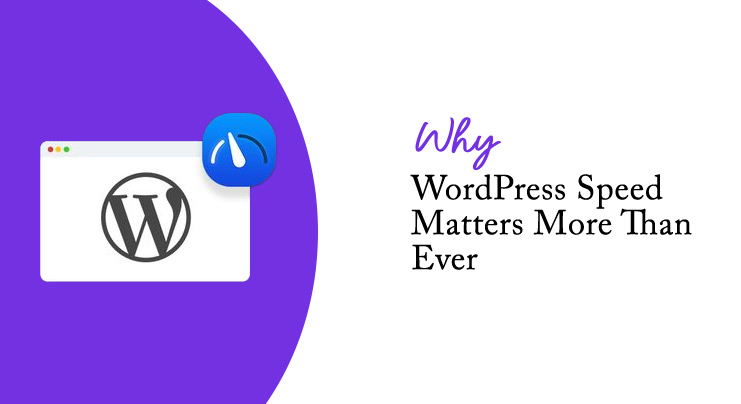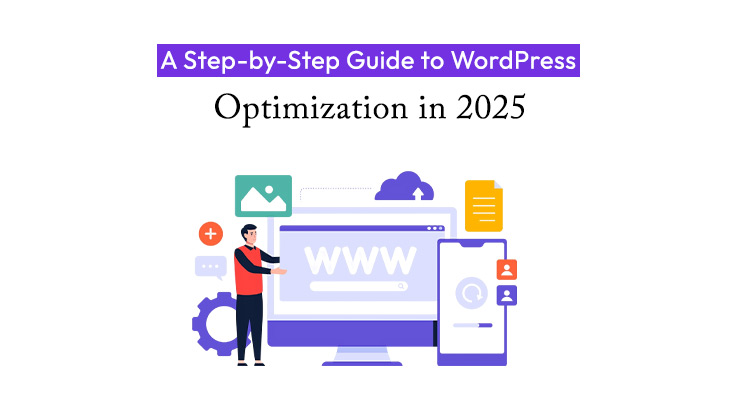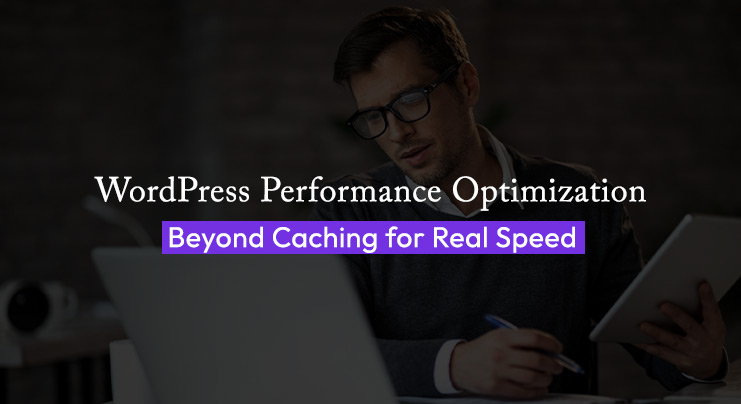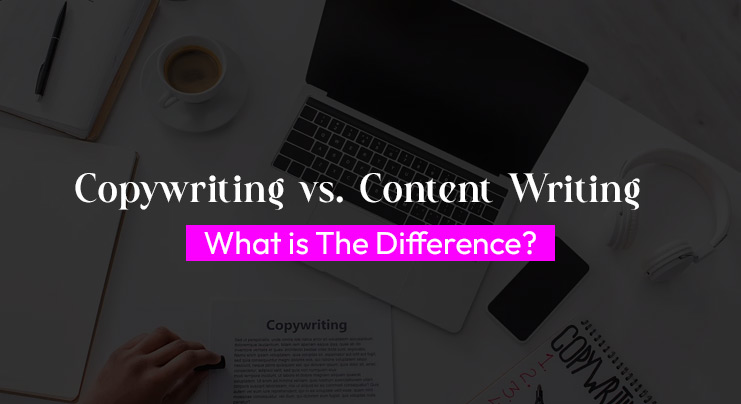If you have ever installed a caching plugin, refreshed your WordPress site, and thought, “Why is it still slow?” — you’re not alone.
Caching is a first step in WordPress performance optimization, but it’s far from a complete solution. True speed requires going deeper — into your database, assets, hosting setup, and even how WordPress itself is structured.
In this blog, we will explore the hidden bottlenecks most developers overlook, the advanced techniques that separate fast sites from sluggish ones, and a clear roadmap to make your WordPress site genuinely fast.
Why WordPress Speed Matters More Than Ever
Before diving into advanced WordPress performance techniques, it’s also important to choose the right platform. If you’re comparing Shopify vs WordPress for the best eCommerce platform, understanding performance is just one factor to consider.
- Search Engine Optimization (SEO):
Google’s Core Web Vitals are now official ranking signals. Slow load times push WordPress site speed improvement that also helps in SERPs position. - User Experience (UX):
Visitors expect a site to load in under 2–3 seconds. Anything slower increases bounce rates. - Conversions & Revenue:
A 1-second delay in load time can reduce conversions by 7%. For eCommerce, that means real money lost. - Scalability:
A slow WordPress site may collapse under traffic spikes — whether from viral content, a product launch, or seasonal sales.
Caching helps, but building a high-performance WordPress site requires going beyond.

Why Caching Alone Doesn’t Solve WordPress Performance
Most developers install a caching plugin, see improvements, and stop there. The issue? Caching only masks performance problems.
Real Bottlenecks Caching Can’t Fix
- Bloated WordPress Databases: Years of post-revisions, transients, and spam comments.
- Render-Blocking CSS & JavaScript: Extra assets loaded on every page.
- Oversized Images: Large, optimized images slow down load times.
- Weak Hosting Environments: Shared hosting can’t handle heavy WordPress queries.
Think of caching as adding a turbocharger to a car with a clogged filter — you will never reach peak performance until deeper issues are fixed.
A Step-by-Step Guide to WordPress Performance Optimization in 2025

Step 1: WordPress Database Optimization
The database powers every WordPress page load. A bloated or inefficient database slows your entire site.
- Monitor Queries
Use Query Monitor to find slow or repeated queries. - Clean Up Unnecessary Data
Remove:- Old post revisions
- Expired transients
- Spam/trashed comments
Tools: WP-Optimize, Advanced Database Cleaner.
- Implement Object Caching
For high-traffic sites, object caching in WordPress (Redis/Memcached) improves query efficiency.
Many managed hosts include Redis by default.
Benefit: Faster response times and reduced server load.
Step 2: WordPress Asset Optimization
CSS, JS, fonts, and images often cause the heaviest drag on WordPress site performance.
- Remove Unused CSS & JS
- Use Asset CleanUp or Perfmatters to disable assets per page.
- Example: Disable WooCommerce scripts on blog pages.
- Defer or Async JavaScript
Prevent render-blocking by deferring JS execution.- Plugin: Autoptimize.
- Optimize Images
- Convert to WebP/AVIF.
- Compress with ShortPixel or Imagify.
- Serve scaled images only.
- Enable Lazy Loading
Essential for WordPress mobile performance optimization.
Step 3: Advanced WordPress Optimization Techniques
Go beyond the basics with these strategies:
- Use a Content Delivery Network (CDN) for WordPress
Global delivery reduces latency.
Popular options: Cloudflare, Bunny.net, KeyCDN. - Implement Edge CachingWordPress
Cache entire HTML pages closer to users.- Solutions: Cloudflare Workers, Vercel Edge Functions.
- Solutions: Cloudflare Workers, Vercel Edge Functions.
- Consider Headless WordPress
Use WordPress as a backend + React/Next.js frontend.- Benefits: App-like speed, flexible APIs, scalable builds.
- Benefits: App-like speed, flexible APIs, scalable builds.
- Mobile-First WordPress optimization
Google’s mobile-first indexing makes mobile WordPress optimization critical.- Use responsive images
- Minimize DOM size
- Avoid heavy scripts
Step 4: Hosting & Server Optimization
Even with caching and clean assets, poor hosting can bottleneck speed.
- Hosting Options
- Shared Hosting: Cheap but resource-limited.
- Managed WordPress Hosting: (Kinsta, WP Engine, Flywheel) — optimized for WordPress performance.
- VPS/Dedicated Servers: Best for scaling enterprises.
2. Server Improvements
- Upgrade to PHP 8.x for better performance.
- Ensure HTTP/2 or HTTP/3 support.
- Consider dedicated database hosting for large WordPress setups.
Step 5: Ongoing WordPress Performance Monitoring
Optimization is not a one-off project.
Ongoing tasks:
- Test with Google PageSpeed Insights, GTmetrix, WebPageTest
- Track Core Web Vitals in Google Search Console
- Quarterly plugin audits with Improve WordPress performance
- Keep WP core, themes, and plugins updated
- Always back up before major updates
Continuous monitoring = sustainable WordPress speed optimization.
Quick WordPress Performance Checklist 2025
- Database: Clean junk data, monitor queries, enable Redis/Memcached
Assets: Remove unused CSS/JS, optimize images, lazy load
Advanced: CDN, edge caching, headless WordPress performance , mobile-first
Hosting: Managed WordPress hosting, PHP 8.x, HTTP/3
Ongoing: Monitor CWV, audit plugins, update regularly
Case Study: WooCommerce Store Optimization
Challenges:
- 50,000+ post revisions
- 20+ scripts loading per page
- Unoptimized images
- Hosted on shared server
Actions Taken:
- Database cleanup + Redis object caching
- Disabled unnecessary CSS/JS
- Converted images to WebP
- Migrated to managed hosting with CDN
Results:
- Load time dropped from 6.5s → 1.9s
- Passed Core Web Vitals WordPress benchmarks
- +18% conversions within 2 months
Proof: Comprehensive WordPress performance optimization delivers measurable business growth.
Supercharge Your WordPress Performance
Caching is useful, but it’s not a silver bullet. Real WordPress performance optimization means addressing your database, assets, hosting, and delivery methods holistically.
At Fulfillit, we specialize in WordPress performance optimization services that go far beyond caching. From Core Web Vitals tuning and image optimization to CDN setup and hosting migration, we make your WordPress site fast, scalable, and revenue-driven.
Don’t settle for “just okay” speed. Let’s build a site that loads in seconds, ranks higher, and converts better. Contact Fulfillit today to unlock your WordPress site’s full potential.
FAQs related to WordPress Performance Optimization
What can I do to make WordPress faster than caching?
You may do more than caching, optimizing the database, eliminating dead CSS/JS, compressing images, lazy loading, upgrading hosting, and a CDN. These plans provide Optimize WordPress performance in a sustainable manner.
Which is the most excellent WordPress performance optimization?
It does not have a single solution. The combination of WP-Optimize (database cleanup), Autoptimize (CSS/JS optimization), ShortPixel (image compression) and Redis (object caching) is the ideal solution. The combination of the two enhances WordPress speed and Core Web Vitals.
Is hosting a performance issue with WordPress?
Yes. Shared hosting is resource-constraining, which tends to slack down on WordPress sites. Managed WordPress hosting and VPS have better and faster servers, PHP 8.x, and inbuilt caching, which is significant in real optimization of performance in WordPress.
What is the importance of Core Web Vitals to WordPress SEO?
Core Web Vitals is a ranking signal of Google. A slow WordPress site that has low CLS, LCP or FID scores can lose search positions. The performance maximization increases SEO and user experience.
Does WordPress need a CDN in order to be fast?
Yes, particularly to the global audiences. A Content Delivery Network (CDN) lets the assets be stored in a global network thereby decreasing the latency. Together with edge caching, it is also one of the best methods of scaling the speed of WordPress.










